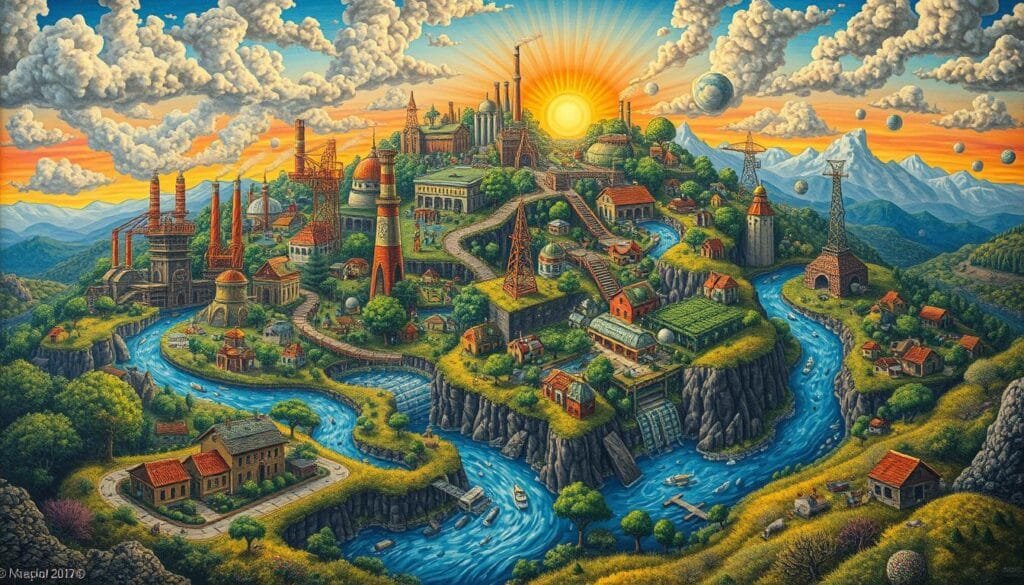What if a state’s true identity isn’t just about culture, but also its economy? In our world today, how a country handles its economy shapes its foundation. This is because economic policies play a big role in state-building. As states grow and face new challenges, we look at their economies to judge their governance and progress.
We’re going to look at how states use their economies to stand out. We’ll see how economic decisions affect what governments do and how people live. We’ll examine the mix of public and private sectors and the impact of tech. This will show us how crucial economics are in building a state.
Are you ready to learn how economies influence states? Let’s dive deeper.
Discover more about what defines the U.S. economy. We’ll look at GDP, CPI, and more. This gives us a full view of our economic health.
Key Takeaways
- Economic policy and political economy are essential to state-building.
- Economic frameworks influence governance and societal progress.
- A state’s economic identity can reflect more than just cultural heritage.
- Equilibrium between public and private sectors is crucial.
- Technological advancements play a significant role in economic growth.
Introduction to Economic State-Building
Economic state-building has been crucial in forming nations. We explore the historical and conceptual bases that highlight its importance in today’s economies.
Historical Context and Importance
Early economic policies shaped state-building significantly. The American Revolution focused on economic freedom, and the Marshall Plan was vital for Europe’s rebuild. These examples show how essential state-building has been.
Over time, as the world changed, so did the role of state-building. It became a key aim globally. Knowing this history helps us understand present efforts.
“Lessons from the past inform our approach to building resilient economic frameworks for the future.”
Conceptual Foundations
The importance of economic state-building is clear, but its basics can be confusing. This part looks at key ideas and how they differ from nation-building and governance. These insights are critical for shaping effective strategies.
We aim to create strong economic principles for navigating today’s state-building challenges.
The Role of Domestic and International Actors in State-Building
Understanding state-building requires looking at both local and global players. Their teamwork deeply impacts how well state-building works.
Importance of Domestic Actors
Local actors are crucial in state-building as they understand the context and bring legitimacy. They include government officials and civil society, deeply connected to their country’s issues. They truly want their nation to thrive.
However, they face hurdles like corruption and power struggles. For public services to improve, they need good governance, security, and strong laws.

Impact of International Actors
Foreign influence in state-building is huge. Foreign governments and NGOs offer valuable help. But their presence can cause problems too.
While they support and provide expertise, they must not take over. Balancing local authority and new institutions is key during early state development.
Coordination Among External Entities
Working together in state-building is complex but necessary. Many groups are involved, and they should act in unity. Yet, knowing the best way to do this is hard.
Donors face the challenge of supporting without overpowering local governments. They struggle with learning from past mistakes to work together better.
| Key Challenges | Description |
|---|---|
| Political Economy Factors | Issues like corruption and competition for power within domestic realms. |
| Knowledge Gaps | Limited evidence-based knowledge on effective state-building strategies. |
| Coordination Difficulties | Challenges in synchronizing actions among international donors and local actors. |
Both local and global actors are essential to state-building. They need to work together wisely. Sharing knowledge and understanding local needs better can improve results.
The Political Economy Perspective on State-Building
Understanding the political economy in state-building means looking at two key areas. We examine both constitutive and output domains which shape how states operate. This includes how they provide services and how they handle their responsibilities. This section dives into these areas, showing the hurdles in state growth and the insights gained from past and current examples.

Constitutive and Output Domains
The foundation of the political economy in state-building lies in constitutive domains. These include political settlements and frameworks for administration. For example, political centralization is crucial for a country’s economic health. Data from 1000 to 2000 shows Western Offshoots, known for strong governance, led in GDP per capita.
In Africa, regions with solid pre-colonial ethnic institutions now better deliver public services. This shows the lasting impact of well-established institutional frameworks on a country’s prosperity.
When we talk about output domains, we mean the state’s role in providing services and goods to its people. This covers public services, collecting taxes, and developing infrastructure. In Colombia, a stronger state presence led to less violence, better education, and lower poverty. These are key measures of a state’s development success.
Challenges and Lessons Learned
Building a state comes with its own set of complex challenges. These include maintaining control, taxing effectively, and managing the economy. Historical patterns show early states often grew fast economically. But, interestingly, not all are wealthy today. This contradiction points to the intricate nature of state roles and their impact over time.
In Eastern Congo, during the civil war, armed groups grabbed resources and influenced governance. This weakened the state’s authority. Also, a dictator’s grip on power can negatively affect a country’s economic health. These scenarios shed light on the balance between political stability and economic outcomes.
France’s history with tax systems teaches us important lessons, too. Military advances and external threats pushed France from tax farming to direct taxation in the 18th century. This improved fiscal collection highlights how internal changes and external pressures can drive state growth.
Looking at Colombian municipalities gives us a real-life example of these ideas at work. Increasing state presence in areas improves public safety and economic standing. This offers a clear strategy for modern state-building efforts.
Collectively, these insights offer a deep understanding of the political economy in state-building. They help chart a course for enhancing state capabilities and overcoming development challenges.
Understanding Economic Ecosystems
We explored the idea of economic ecosystems, revealing a complex framework. This framework helps us see how local and global economies connect. Like nature’s ecosystems, economic ones have parts that work together. They keep the system healthy and growing. They include ‘containers’ for storing resources, ‘faucets’ to spread them out, and ‘drains’ where resources leave.

Learning about economic ecosystems shows their role in building local economies. It helps in creating ways to grow economies sustainably. By using resources wisely, areas can improve their output and handle economic ups and downs better.
We looked at ecological economics and its goals: sustainable size, fair share and smart use. These goals help people’s lives and ensure our future. They guide the building of thriving local economies that fit well in the world market.
It’s key to consider both natural elements and society in economic development strategies. Using things like carbon pricing helps achieve market balance and protects our planet. This helps in making markets work better and staying green.
Robert Frank suggested a tax plan that would help save more by taxing what we buy. This supports smart investments that help economic ecosystems stay healthy.
Ecosystem service markets are varied, from global to local services. Recognizing these services is crucial. It calls for plans that recognize the unique needs of local economies. This way, they can manage their resources well.
Our study highlights the need to blend ecological economics into local planning. Aiming for economies that respect nature’s bounds, we suggest aiming for steady-state economies. These systems aim for sustainable growth that matches Earth’s natural limits.
| Component | Description |
|---|---|
| Containers | Store economic resources within the ecosystem. |
| Faucets | Distribute resources across various sectors of the economy. |
| Drains | Points where economic resources exit the ecosystem. |
Encouraging strong economic ecosystems helps local economies flourish. They become tough and able to last. This method shows the importance of developing smart, flexible, and earth-friendly economic development strategies.
What State Uses Economics to Define Their Identity?
States often shape their identity using economic strategies. Economic nationalism emphasizes state control in the economy. It differs from economic liberalism and socialism.
Economic nationalists see international trade as harmful. They support protectionism over free trade. The mercantilism theory focuses on growing national wealth.
In Italy during the 1800s, economic thinkers pushed for protectionism. This move significantly shaped Italy’s economy but led to a crisis in 1887. The Austro-Hungarian Empire’s economic divide among ethnic groups led to demands for independence, causing its fall.
| Policy | Country | Impact |
|---|---|---|
| Protectionism | Italy | Economic Crisis (1887) |
| Limits on Foreign Ownership | Russia | Control of Natural Resources |
| Classifying Industries as Strategic | France | Prevented Takeovers |
| National Port Management | U.S. | Political Opposition |
In 1974, U.S. Treasury Secretary William E. Simon warned about inflation leading to economic nationalism. Countries often turn to economic strategies for identity. Policies like Russia’s 2008 move to limit foreign ownership demonstrate this trend.
It’s clear that economic and national identities are closely linked. Nations use trade, protectionism, and unique strategies to define themselves. Economic nationalism continues to influence global policies, shaping how states see their economic identity.
The U.S. Mixed Economy: A Case Study
The U.S. mixed economy combines private ownership with state intervention. It has changed a lot since the post-World War II era. It mostly favors private production. Yet, it includes government actions like subsidies and rules, especially in key sectors such as agriculture and healthcare.
Government actions aim to stabilize markets and help with social welfare. Programs like SNAP, Medicaid, and public housing support those with low incomes. This approach differs from many Western European countries, which have higher taxes due to extensive social welfare and state healthcare.
State intervention appears in forms like price controls and minimum wage laws. These policies aim to stop the exploitation of workers. Yet, they might lead to fewer job opportunities. Subsidies in agriculture help keep the economy strong and stabilize farmer earnings.
Nonetheless, not everyone supports the American economic model. Some are concerned about regulatory capture. This is when certain industries get beneficial rules, affecting market fairness. Others think that in mixed economies, policies can misallocate resources and cause imbalances.
The U.S. economy has shown both resilience and volatility. The COVID-19 pandemic triggered a GDP drop of 3.5% in 2020. This was the sharpest decline since World War II. But, before this, the economy expanded for over ten years. An early 2021 GDP growth forecast of 6.6% signaled a possible quick recovery.
The U.S. still leads in nominal GDP globally, despite China leading in real GDP. This shows the strength of the U.S. mixed economy. It successfully blends market practices with necessary state acts, maintaining global trade and financial ties.
Exploring the mixed economy shows the interplay between private firms and government action. It influences important economic results. The U.S. mixed economy is an important example. It highlights both advantages and challenges of this economic approach.
Conclusion
Reflecting on economic state-building reveals its rich diversity and complexity. Our journey showed how economics blends with political science and other fields. This blend highlights how economics shapes policies and social norms.
We saw the key roles of both micro and macroeconomics. Microeconomics focuses on individuals and shows the impact of resource limits. Macroeconomics looks at the big picture, helping guide policy-making with data like GDP.
The future of state economics demands flexibility to face global issues. Economists often debate on policies, showing how dynamic the field is. Grasping economic policy effects is vital for all involved in this area.
Our look at the U.S. mixed economy brought economic theories to life. It showed why combining theories and practice is essential. As economics grows, embracing diverse educational and policy approaches will guide global economic futures.
FAQ
What is the historical significance of state-building?
State-building started with forming modern nation-states. It has grown over the centuries. Today, it’s key for political stability and growth.
How do economic policies shape state functions and responsibilities?
Economic policies define state roles by affecting resource use and regulations. They influence public services and a nation’s economic identity.
What are the key distinctions between state-building, nation-building, and governance?
State-building builds political and administrative systems. Nation-building creates a shared national identity. Governance is about managing state power and resources. Each one needs a smart, informed approach.
Why are domestic actors important for state-building initiatives?
Local governments and organizations are vital for state-building. They know the local context and help make initiatives work on the ground.
How do international actors influence state-building efforts?
Foreign entities help through money, expertise, and policy advice. Their impact depends on how well they work with local strategies.
What challenges arise in coordinating external entities during state-building?
Challenges include aligning goals and managing different agendas. Good coordination needs planning and communication to be effective.
What are constitutive and output domains in the context of state-building?
Constitutive domains form the state’s foundation like political systems. Output domains handle public services. Both are crucial for building a state.
What lessons have been learned from past state-building efforts?
Lessons highlight the need for tailored strategies, inclusive politics, and continuous support. Learning from past successes and failures is critical.
How do economic ecosystems function at the local scale?
Local ecosystems use resources like ‘containers’ and ‘faucets’. They aim to keep economic benefits, boost productivity, and manage resources for development.
Can you give examples of states that define their national identity through economic strategies?
Singapore and China use economic strategies to shape their identity. These strategies impact their policies and international standing.
What is the mixed economy model of the United States?
The U.S. has a mixed economy with private and public sectors. This balance has evolved, affected by policies from the New Deal to present.
